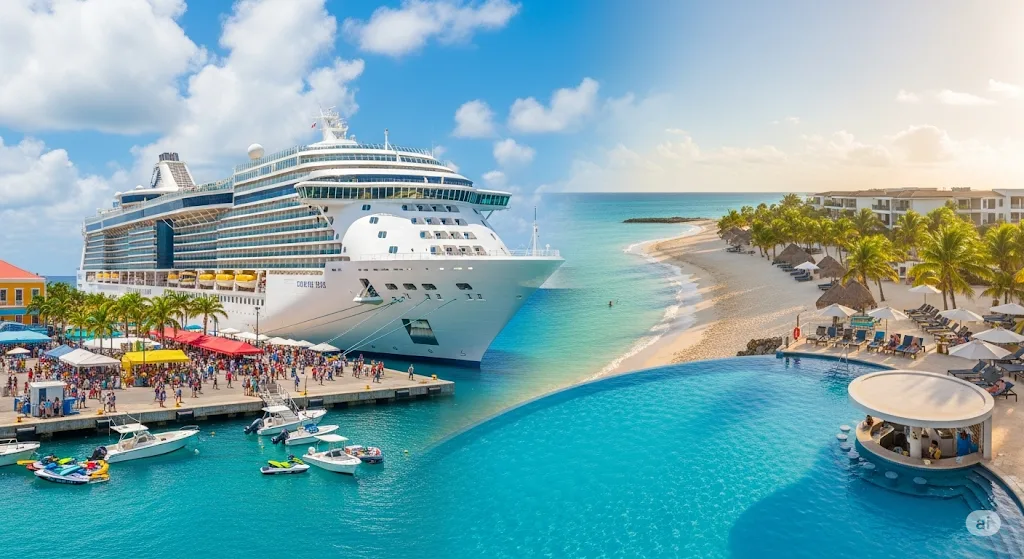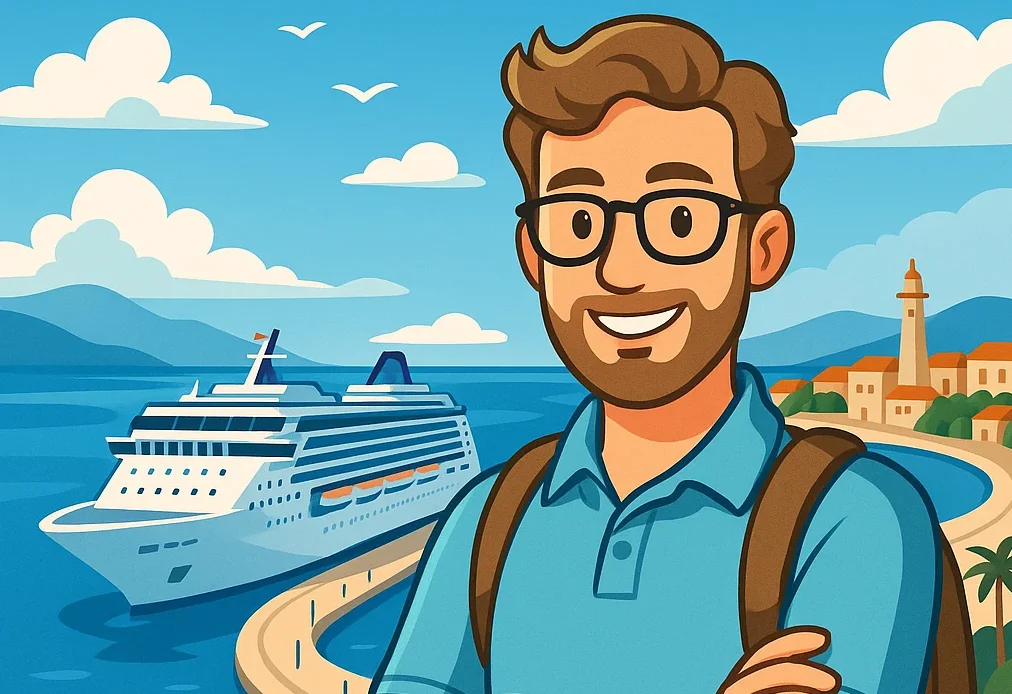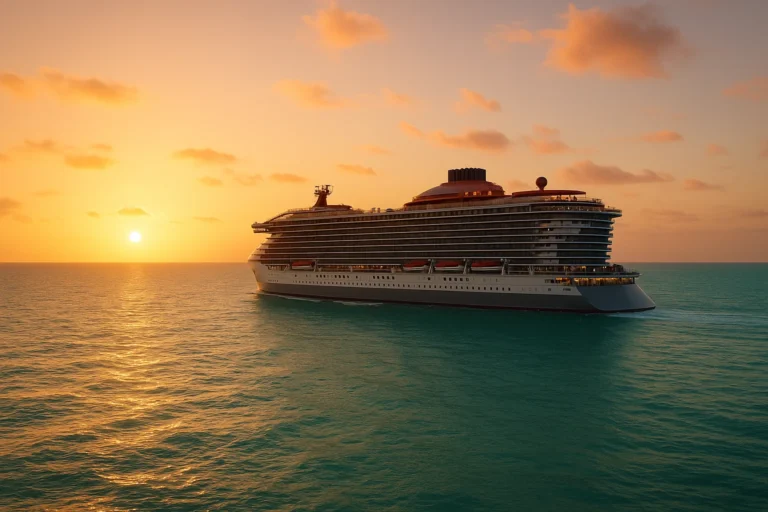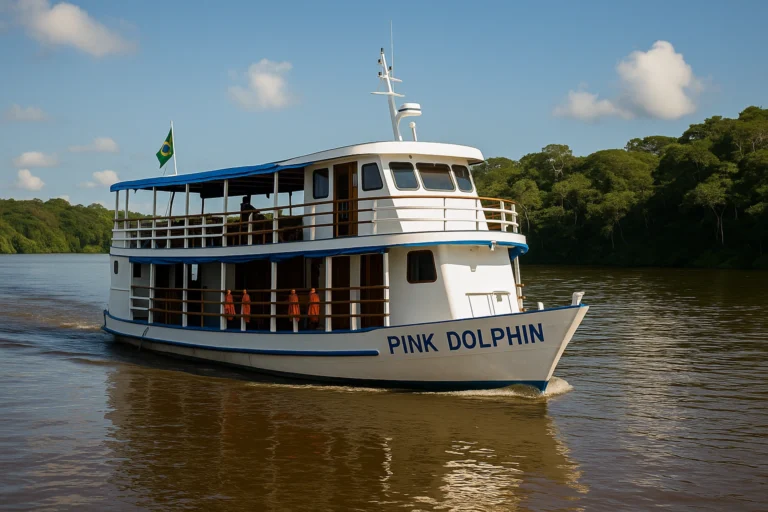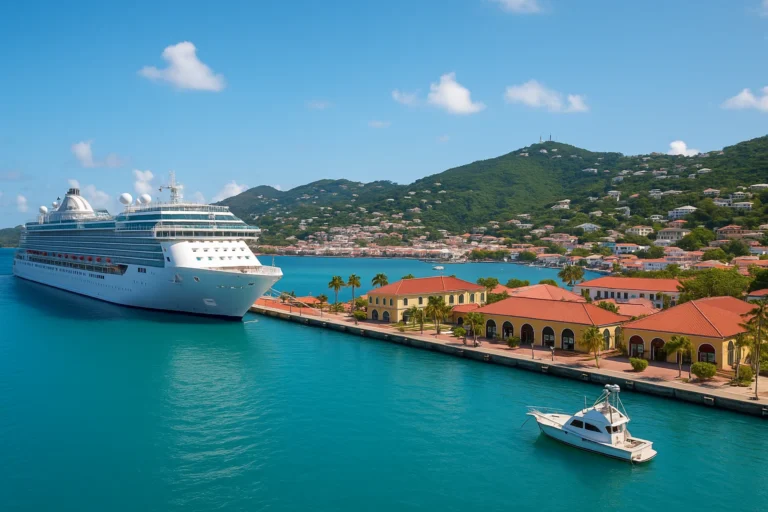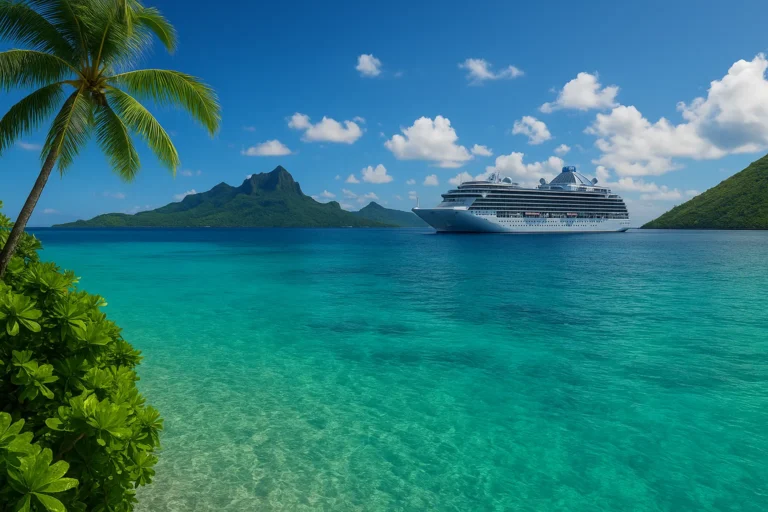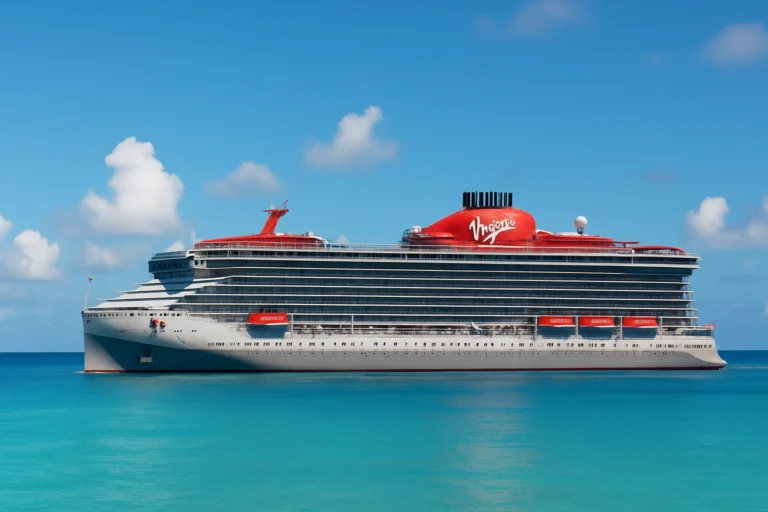Caribbean Cruise vs. All-Inclusive Resort: Which is the Best Vacation for You?
Making the Best Choice for Your Next Getaway: Caribbean Cruise vs. All-Inclusive Resort, Choosing between a Caribbean cruise and an all-inclusive resort is one of the biggest dilemmas for any traveler seeking a warm-weather escape. While both promise sunshine, relaxation, and stunning ocean views, they offer fundamentally different experiences. One is a floating city of adventure that takes you to multiple destinations; the other is a singular, stationary haven of tranquility. This comprehensive guide breaks down the key differences, helping you understand the pros and cons of each, so you can decide which option is the perfect fit for your ideal vacation.
Chapter I: The Core Experience – A World of Difference
At their heart, a cruise and an all-inclusive resort are built on completely different travel philosophies. They cater to distinct types of travelers and offer opposing, yet equally appealing, vacation rhythms. Understanding this core difference is the first step to making the right choice.
The Cruise Lifestyle: A Floating City of Adventure
A Caribbean cruise is an active, itinerary-driven vacation. It’s a logistical marvel, where your accommodation, dining, and a vast array of entertainment options all travel with you. The primary appeal lies in its ability to transport you from one stunning destination to another, often overnight, so you wake up with a new island to explore almost every day. It eliminates the hassle of multiple flights, hotel transfers, and constantly packing and unpacking. The ship itself is a destination, a self-contained world designed for non-stop action and entertainment. You’ll find everything from Broadway-style theaters and casinos to rock-climbing walls, ice-skating rinks, and multiple swimming pools. It’s an all-in-one vacation where the journey is just as important as the destinations.
This model is ideal for explorers, for those who want to get a taste of different cultures and landscapes in a single trip. The social atmosphere is lively and communal, as you’re constantly surrounded by a diverse mix of people, from families to couples and solo travelers. It’s a highly structured vacation, where you need to be mindful of port times and on-board schedules, but in return, you get an incredible amount of variety and a constant sense of forward momentum.
The All-Inclusive Resort Lifestyle: A Stationary Sanctuary of Relaxation
An all-inclusive resort, on the other hand, is a destination in itself. Once you arrive and unpack, you can fully immerse yourself in a single, beautiful location. The focus is on unhurried relaxation, comfort, and having everything you need within a few steps. These resorts are meticulously designed to be self-contained paradises, providing guests with unlimited access to food, beverages (including alcohol), and a wide range of on-site activities and amenities. The goal is to remove all stress from the vacation experience—you never have to worry about carrying a wallet, searching for a restaurant, or finding entertainment. The environment is one of consistent calm and a personal rhythm. You can choose to spend the entire day by the pool, lounging on a beach chair, or enjoying a quiet moment on your private balcony.
This type of vacation is perfect for those who want to completely unwind, de-stress, and simply exist in a beautiful setting without the pressure of a schedule. It’s a retreat, a place to recharge your batteries and focus on personal well-being. While day trips and excursions are often available for an extra fee, they are optional, not a core part of the experience. The freedom to do absolutely nothing is the greatest luxury an all-inclusive resort can offer.
Chapter II: The Budget Breakdown – Understanding the True Cost
The “all-inclusive” label can be misleading for both vacation types. While they offer a transparent pricing model, it’s crucial to understand what is truly included in the upfront cost and what will require additional spending. This is where many travelers get caught by surprise.
Understanding the Cruise Fare: The Price of Convenience
The initial booking price for a cruise is often the main draw. It looks incredibly cheap for a multi-destination trip. This base fare typically covers your cabin, meals in the main dining rooms and buffet, and most on-board entertainment like shows and live music. However, it’s the “extra” costs that can quickly balloon your final bill. The average cruiser can expect to spend an additional 30-50% on top of the base fare. Key add-ons include:
- Gratuities: These are often mandatory and automatically added to your daily bill, typically ranging from $14 to $20 per person per day.
- Beverage Packages: A standard cruise fare only includes water, iced tea, and basic coffee. If you want soda, bottled water, or alcoholic beverages, you’ll need to purchase a drink package. These can cost anywhere from $60 to $100 per person per day.
- Shore Excursions: The cost of exploring the ports is not included. A typical excursion can cost between $50 and $150 per person, and a more adventurous one can be upwards of $200.
- Specialty Dining: While the main dining is included, the best-rated restaurants on board are typically extra. A meal here can range from $25 to $75 per person.
- Wi-Fi and On-Board Activities: Wi-Fi packages, fitness classes, and other premium activities (e.g., go-karts, escape rooms) are almost always an additional charge.
The beauty of a cruise is that you have control over these costs; you can choose to skip the specialty restaurants and shore excursions and still have a wonderful time. However, to get the full experience, it’s essential to budget for these add-ons. The flexibility is a double-edged sword: you save money by not paying for things you won’t use, but you risk feeling like you’re constantly being “nickeled and dimed.”
Understanding the All-Inclusive Price: The Price of Predictability
All-inclusive resorts, as the name promises, aim to minimize the surprises. The upfront cost is higher, but it includes the vast majority of what you will consume and experience. The cost typically covers your room, all meals at every restaurant on the property (from buffets to a-la-carte), unlimited drinks (often including premium alcohol), and most on-site activities like kayaking, snorkeling, and fitness classes. The financial predictability is a huge relief for many travelers.
While the goal is no extra costs, you should still be aware of a few potential fees, such as spa treatments, certain high-end alcohol brands, or special-request activities. For the most part, however, what you see is what you get. This makes it much easier to budget for the total cost of the vacation without fear of a surprise bill at the end. The only real variable cost is the tip for staff, which is often discretionary and based on service quality. For travelers who want to simply arrive, relax, and not think about money for a week, the all-inclusive resort model is often a superior choice.
📂 Explore More in These Categories
Best Cruise Destinations in 2025: Caribbean, Europe & Bucket List Ports
Best Cruise Lines in 2025: Compare Luxury, Family & Budget
Compare Cruise Lines – MSC vs Royal, Carnival vs Norwegian & More
Chapter III: The Traveler’s Personality – Explorer vs. Unwinder
Your ideal vacation isn’t just about the money; it’s about what you want to achieve with your time off. The choice between a cruise and a resort can be a reflection of your personality and travel style.
For the Explorer: The Allure of Cruising
If you’re a person who loves to see and do it all, a cruise is your perfect match. The “moving hotel” concept is a dream for those who crave variety and efficiency. In a single 7-day cruise, you can visit three or four different countries or islands, experiencing distinct cultures, landscapes, and cuisines. You might explore the Mayan ruins in Cozumel, hike a volcanic trail in St. Lucia, and relax on the famous beaches of Aruba, all without ever stepping foot on an airplane after your initial flight to the departure port. The thrill of waking up to a new view every morning is a core part of the cruising experience. You can choose from a variety of itineraries, from the Eastern Caribbean (St. Thomas, Puerto Rico, etc.) to the Western Caribbean (Mexico, Jamaica, etc.) or the Southern Caribbean (Aruba, Curacao, etc.), each offering a different type of adventure.
For the Unwinder: The Promise of an All-Inclusive Resort
If your idea of a perfect vacation is to hit the reset button, an all-inclusive resort offers the ultimate promise of tranquility. The freedom from a schedule is its greatest gift. You don’t have to worry about disembarkation times, tour schedules, or navigating new places. Your only mission is to relax. This is the ideal option for people who have demanding jobs, busy lives, or are simply tired of the constant pressure of modern life. It’s an opportunity to truly disconnect, to spend hours reading by the pool, to enjoy a leisurely meal, and to simply exist in a state of peace. You can fully immerse yourself in the culture of a single place, getting to know the staff, the local flavors, and the rhythm of the community. For a honeymoon, a romantic getaway, or a solo trip focused on self-care, a resort offers a level of calm and control that a cruise simply can’t match.
Chapter IV: The Social Dynamics and Family Fit
Beyond personal preference, the social environment and suitability for different travel groups are key factors in this decision. Both options are popular with families, but they cater to them in different ways.
Cruise Social Scene: A Melting Pot of Travelers
The social dynamic on a cruise is often a highlight. It’s a high-energy environment with a mix of shared spaces and intimate corners. Dining can be a social affair, with many cruise lines offering the option of shared tables, making it easy to meet new people. The endless on-board activities, from dance classes to trivia games, naturally foster interaction. For families, cruises are a fantastic choice because they offer a wide range of activities for every age group. Kids’ clubs are staffed with trained professionals and offer age-appropriate activities, giving parents a chance to enjoy some quiet time. Teen lounges and pools offer a safe space for older kids to socialize. The variety ensures that every member of the family is entertained, preventing the “I’m bored” complaint.
Resort Social Scene: Secluded or Social, Your Choice
The resort environment is typically more private and tranquil. While there are shared spaces like pools and bars, social interaction is not the primary focus. You can be as social or as secluded as you wish. Resorts are often designed with quiet zones, adults-only pools, and private dining options that cater to couples and those seeking privacy. For families, many resorts have dedicated kids’ clubs, water parks, and family pools. The benefit here is that the family can maintain a consistent base camp, and kids can get comfortable with their surroundings. The downside is that the variety of activities may be more limited than on a mega-ship. However, the ability to relax in one spot while the kids are entertained is a major draw for many parents.
Chapter V: Navigating the Pitfalls – What to Watch Out For
No vacation is perfect, and both cruises and resorts have potential drawbacks. Being aware of these can save you from a disappointing trip.
For Cruises:
- The Risk of Motion Sickness: This is a very real concern for some travelers. While modern cruise ships have advanced stabilizers, a stormy sea can still cause discomfort.
- The On-Board “Push”: Some travelers report feeling pressured to spend more money on drinks, photos, and other extras once on board.
- The Illusion of Immersion: A quick stop at a port for a few hours doesn’t allow for a deep cultural immersion. You only get a surface-level look at a destination.
- Choosing the Right Cruise: The phrase “which cruises to stay away from” is less about specific lines and more about finding the right fit. A budget cruise line might not be a good idea if you expect a luxury experience. An enormous, family-focused ship might be a bad idea for a couple seeking a quiet, romantic getaway. Research the cruise line’s reputation, ship size, and passenger demographics to avoid a mismatch.
For All-Inclusive Resorts:
- “Resort Fatigue”: For an adventurous soul, being confined to one property for a week can lead to boredom or restlessness.
- Inconsistent Food Quality: While the food is unlimited, the quality can sometimes be inconsistent, particularly at large buffet-style restaurants.
- The “Hidden” Fees: As mentioned earlier, even all-inclusive resorts can have extra charges for premium services. Always read the fine print.
- Lack of Exploration: Without paying for excursions, you may not get to see the authentic culture of the country you’re visiting, as the resort experience can feel sanitized and disconnected from the local community.
Frequently Asked Questions
Common Questions Answered
💬 Make Your Best Vacation Choice!
The perfect vacation isn’t about choosing the “better” option, but about choosing the right one for you. If you crave variety, adventure, and a taste of multiple cultures, a Caribbean cruise is an excellent choice. If your goal is to fully disconnect, relax, and stay in one beautiful location, an all-inclusive resort is your ideal haven. Consider your budget, travel style, and personal preferences, and you’ll be well on your way to an unforgettable trip!


